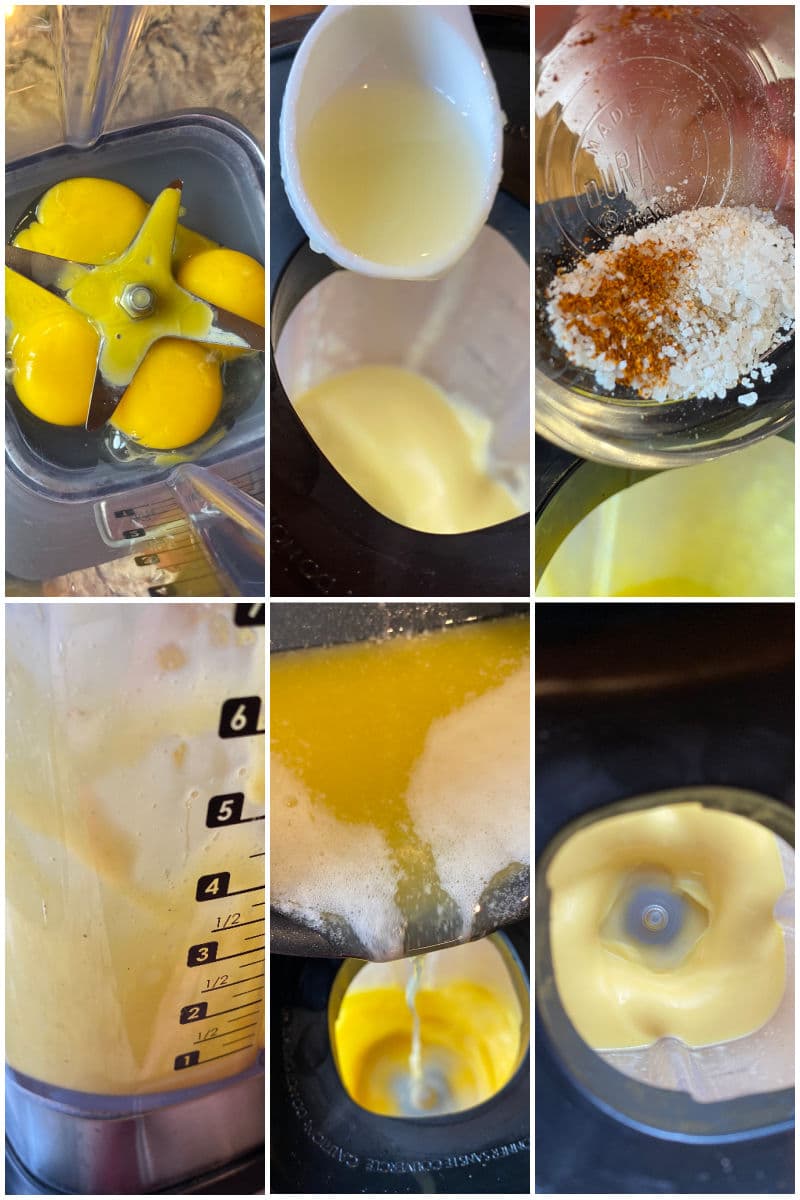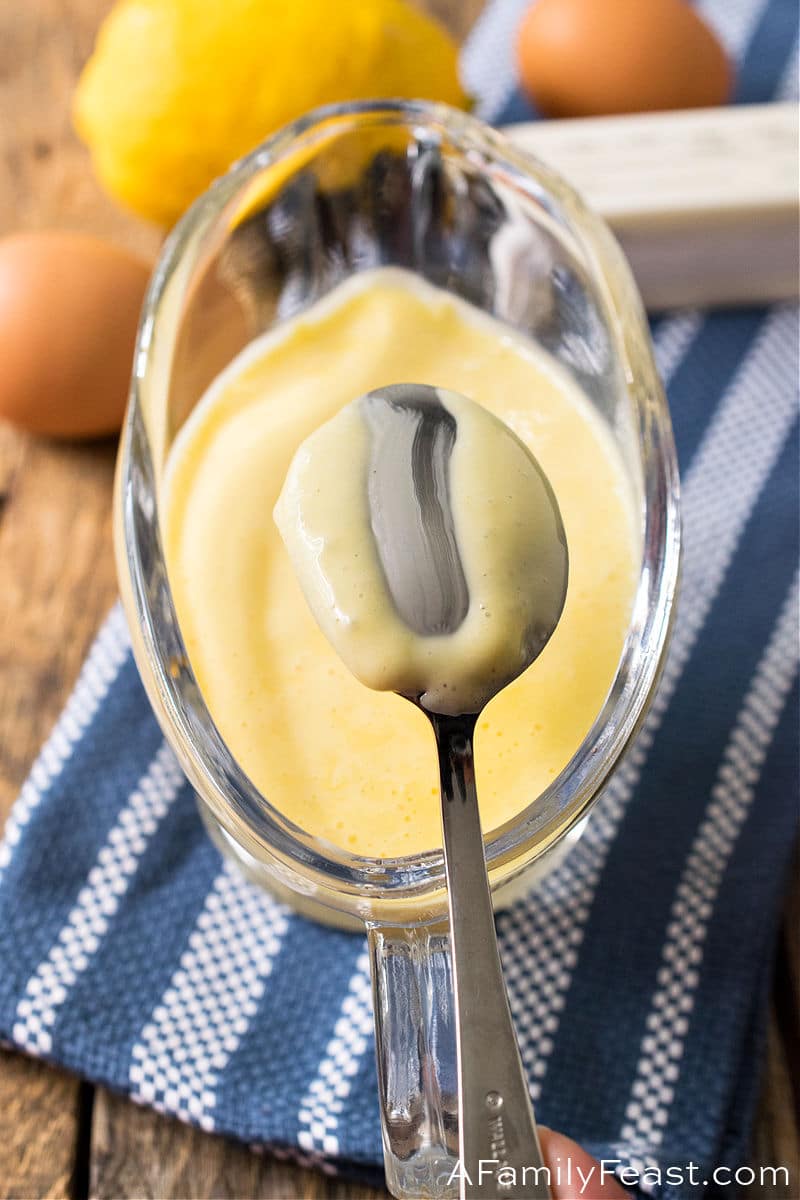Today’s recipe is a much easier way to make silky-smooth Hollandaise Sauce – and it’s made in a blender!
Traditional Hollandaise Sauces are notoriously temperamental and can scare even the most experienced cooks. In the classic recipes, the sauce cooks slowly over a medium-hot water bath– but it can easily over-cook, yielding a lumpy curdled mess.
This method is a much easier way to make a rich and luxurious sauce. It uses coddled egg yolks mixed up in a blender, along with lemon juice and seasonings. Then hot melted butter is stirred in to emulsify and create a creamy Hollandaise with an incredible lemony-buttery flavor.
The friction in the blender heats the coddled egg yolks and essentially cooks them – plus the acid in the lemon juice and the hot butter also make this sauce completely safe to eat. Plus, this Blender Hollandaise Sauce is incredibly quick to prepare and the eggs are less prone to curdling along the way.
For years the blender provided a quick and easy way of making this classic sauce, but now the USDA warns against using this method because the egg yolks do not undergo any cooking. To eliminate any risk, consumers are advised to use canned or packaged Hollandaise sauce, or prepare it by the traditional method.
/Simply-Recipes_Blender-Hollandaise-Sauce_LEAD-2-7933cf694a1c4a5a8809ea66eefc5594.jpg)
How do I make Hollandaise Sauce in a Blender?
- Melt the butter in a small saucepan and keep warm on the stove (but do not allow it to brown or scorch).
- Coddle the eggs, then separate the egg yolks from the egg whites. Measure the yolks (you want exactly ½ cup), then pour into the blender.
- Blend the egg yolks for 30 seconds on medium speed, then add half the lemon juice along with all of the seasoning and blend for another 30 seconds. With mixer running on low, slowly drizzle in the hot melted butter, blending for another 30 seconds after all of the butter is in. Be sure to include all of the butter – including any milk solids that might have separated as it sat in the pan. Taste and add more lemon juice, salt, pepper or cayenne, if needed.
- Serve immediately over poached eggs or Eggs Benedict, asparagus, salmon or other kinds of fish, broccoli, roasted Brussels sprouts, and more.
- Keep the Hollandaise warm by pouring the sauce into a small glass pitcher and placing that into a pan of hot (but not boiling) water to stay warm. Avoid splashing any of the water into the sauce as you handle the pitcher.


Hollandaise Sauce is super thick and creamy. If you dip the back of a spoon in the sauce, then run your finger down the spoon – it’s so thick and decadent, it will stay in place on the spoon.
Although many people do eat raw eggs as a form of protein (I can’t imagine why), Salmonella is a serious risk because it causes 19,000 hospitalizations and 380 deaths a year in the United States according to the Centers for Disease Control and Prevention. Now I know these numbers are quite large, but the risk of an egg being contaminated with Salmonella bacteria is very low at about 1 in 20,000 eggs and is not typically common.
Yet the question still remains, are the eggs in Hollandaise sauce unsafe to eat? The answer lies in the great battle of health versus taste. There are many ways to prevent the infection of Salmonella when storing, preparing, and serving food but, if a step is skipped, the risk becomes greater to the consumer. Essentially, eat your Eggs Benedict at your own risk.
Eggs Benedict isnt your typical American breakfast. Found at your classic diner or upscale brunch restaurant, it’s the kind of breakfast food that has a way of making you feel classy and sophisticated when ordering (especially when pronouncing “Hollandaise sauce”), compared to the basic friends who consistently order the same silver dollar pancakes.
Hollandaise sauce can be made several ways, depending on the chef. Typically, this simple sauce requires egg yolks, butter, salt and cream. Some chefs, such as my personal favorite, Alton Brown (host of Cutthroat Kitchen) tend to make theirs with a little more flare, adding ingredients such as kosher salt and cayenne pepper.
Frankly, many of us amateur cooks just don’t have time for that. The issue that has recently been brought to light about this simple recipe is the potential risk of Salmonella and a bacterial infection due to eggs usually being prepared raw. In order for an egg to be deemed “safe,”
The BEST Way To Make Hollandaise Sauce | Carnivore Recipe (Blender Hollandaise)
FAQ
Is blender hollandaise safe to eat?
How do you make hollandaise sauce safe to eat?
How do you not get sick from hollandaise sauce?
Does hollandaise sauce have raw eggs?
Is Blender hollandaise sauce safe to eat?
In fact, most Blender Hollandaise Sauce recipes don’t provide any disclaimers, but to be extra safe and for peace of mind, I suggest using pasteurized eggs. Pasteurized eggs are just a little more expensive but pasteurization destroys any potential bacteria and viruses so they are completely safe to eat raw.
Can one eat hot sauce?
Hot sauce is considered a healthy condiment when they don’t contain sodium or added sugar. Studies suggest that it can show some health benefits such as supporting heart health and assist in weight loss. However, if you have a sensitive stomach or intestine, you may want to limit the intake.
Can you eat hollandaise sauce?
Although you may feel like royalty consuming this tasty yet pricy meal, recent studies have shown that the Hollandaise sauce that completes this lavish dish could actually be unsafe to eat. Hollandaise sauce can be made several ways, depending on the chef. Typically, this simple sauce requires egg yolks, butter, salt and cream.
What can you eat with Blender hollandaise sauce?
Aside from drinking the buttery bliss, you Blender Hollandaise Sauce is famously fabulous on Eggs Benedict (and my no hassle Eggs Benedict Casserole coming Saturday!) asparagus, fish, shrimp (all types of seafood), filet mignon, most vegetables – and of course Eggs Benedict Casserole. Be excited, be very excited.
